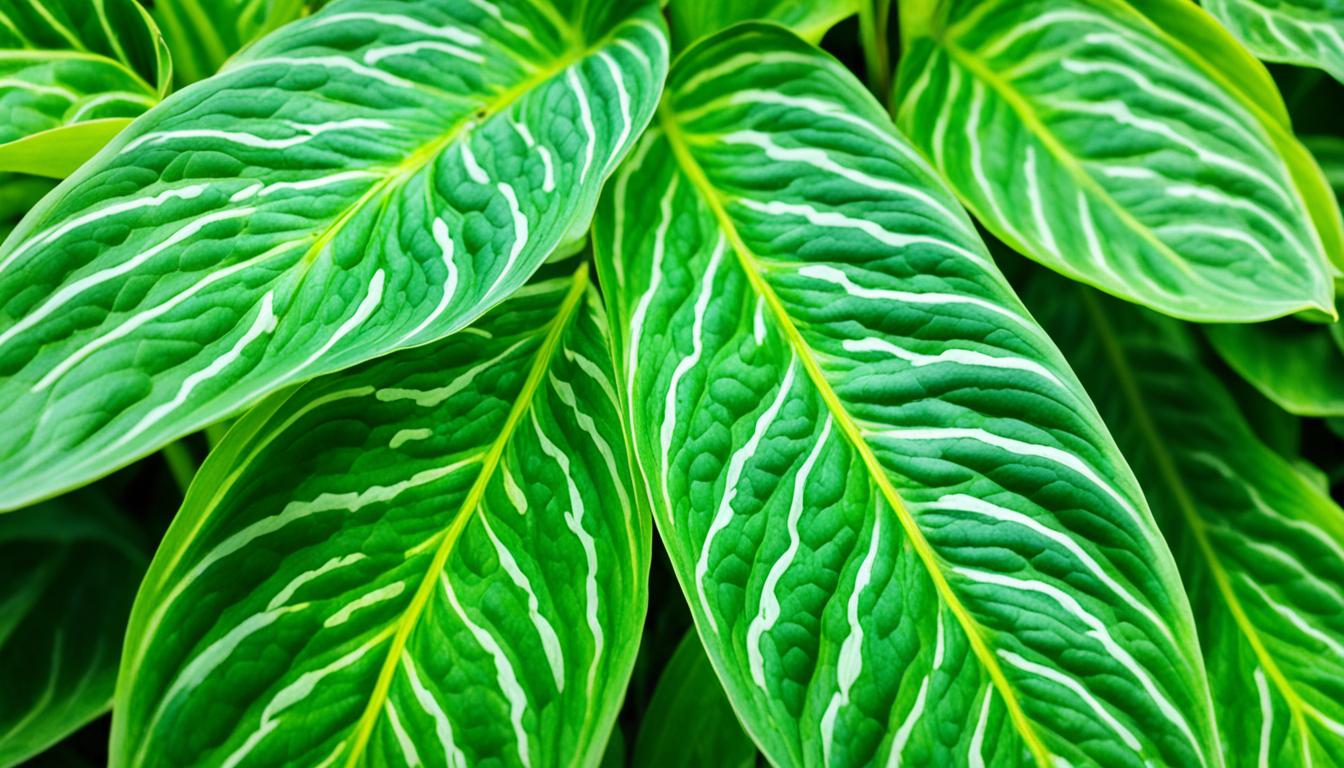Did you know the prayer plant folds up its leaves at night?
This cool plant looks great indoors and adds life to any room. I’ll teach you how to take care of it, keeping it happy and healthy.
Key Takeaways:
- Learn how to care for the prayer plant and create an ideal environment for its growth.
- Discover the best rooms for placing your prayer plant and its air-purifying qualities.
- Understand the light and watering requirements of the prayer plant for optimal health.
- Get tips on propagating and potting prayer plants, as well as dealing with pests and diseases.
- Learn about the different varieties of prayer plants and their unique characteristics.
Why Do We Love The Prayer Plant For Apartments?
The prayer plant is an excellent choice for folks living in apartments. It loves indoor spaces, is small, and doesn’t need much sunlight. Let’s explore why the prayer plant is the perfect houseplant for small apartments.
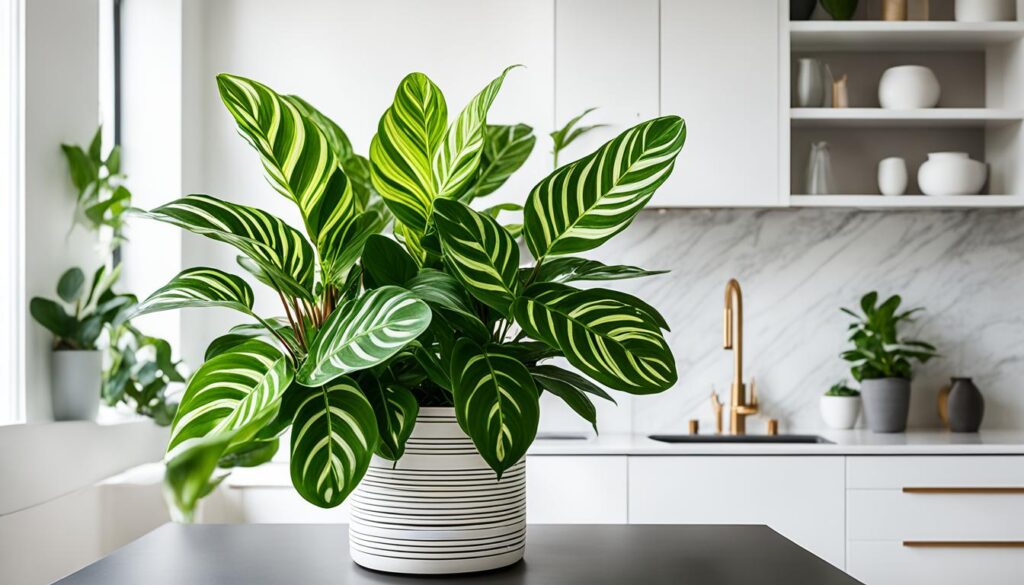
The prayer plant is great for small places. It’s small so it fits on windowsills and tables. It adds green without needing a lot of room. This plant makes any small room or corner lively and vibrant.
This plant also does well in low light. Even if your apartment doesn’t get a lot of sunlight, it can grow. It likes indirect light, which is great for rooms without direct sun. With this plant, even the darkest corner can be green and beautiful.
The prayer plant is also easy to take care of. It doesn’t need a lot of your time or effort. Just water it right and mist it sometimes. Then, it will grow well without much work from you.
| Why We Love The Prayer Plant For Apartments |
|---|
| Compact size fits well in small spaces |
| Tolerates low-light conditions |
| Low maintenance and easy to care for |
Which Is The Best Room For A Prayer Plant?
The best room for a prayer plant depends on a few things. It needs the right light and feel. Prayer plants do well in rooms like the living room, bedroom, bathroom, and office.
Is the Prayer Plant Air-Purifying?
The prayer plant cleans the air, making your room’s air better. It takes in toxins and gives out oxygen. This makes your living space healthier.
Is the Prayer Plant Pet Friendly?
This plant is safe for cats and dogs. You don’t have to worry about it hurting your pets.
How Big Does The Prayer Plant Get?
Indoors, prayer plants can grow up to a foot tall. They are perfect for small spaces. So, you can have them even if you don’t have a lot of room.
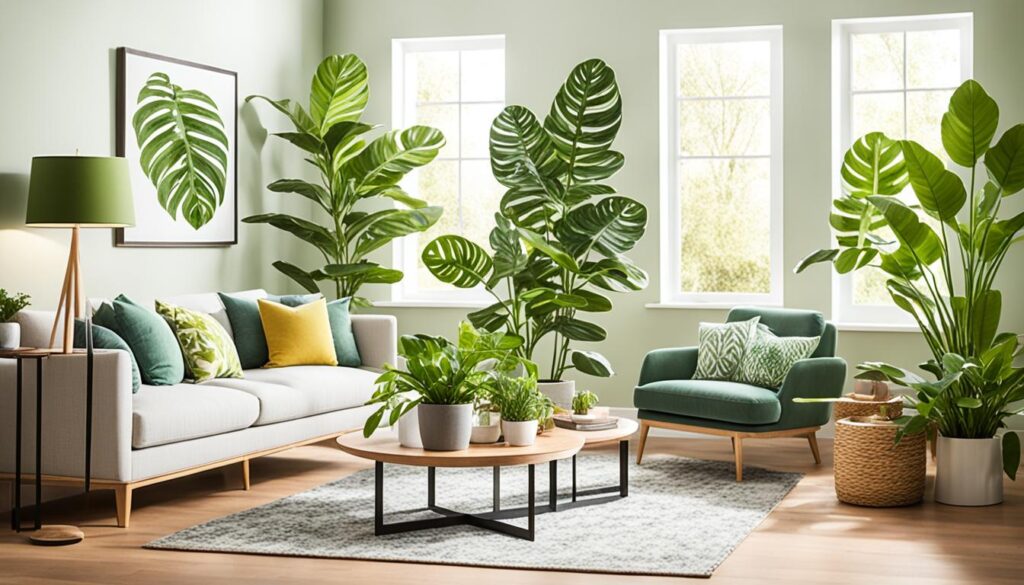
How to Grow a Prayer Plant – Learn to Grow this Indoor Beauty
Growing a prayer plant is rewarding. It lets you bring nature’s beauty inside. Follow this guide for tips to grow a healthy prayer plant.
Choosing the Right Pot and Soil: Pick a pot that drains well and fits the plant’s roots. Use potting mix that keeps moist but isn’t wet.
Providing Adequate Light: Prayer plants need bright, indirect light. Keep it near a window or use grow lights.
Watering and Humidity: Water the plant when the top soil is dry. Don’t overwater. Prayer plants like moist air, so mist them or use a humidifier.
Nutrition and Fertilization: Feed your plant with indoor plant food every month in spring and summer. Use the fertilizer as the label says.
Pruning and Maintenance: Trim off yellow or damaged leaves. This keeps the plant healthy and looking good.
Propagation: You can make more prayer plants from stem cuttings or by dividing the plant. It’s a way to get new plants for free.
Monitoring for Pests and Diseases: Look out for pests like spider mites and mealybugs. Check the plant often and deal with any bugs or sickness right away.
Use these tips for a beautiful prayer plant in your home. Adjust your care to fit the plant’s needs and watch it thrive.
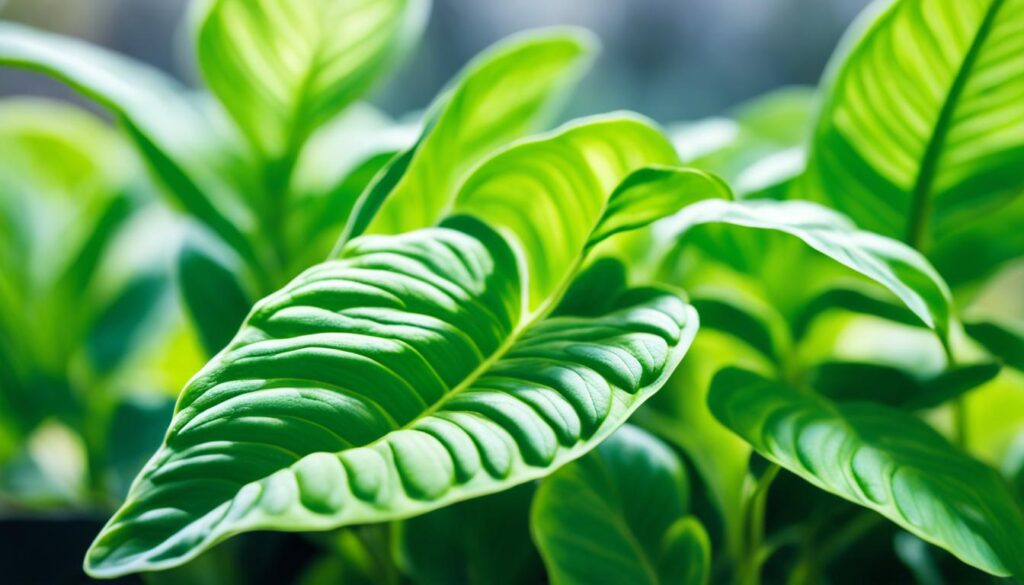
Appearance of Prayer Plant
The prayer plant is very pretty. It has big leaves that make spaces look nice.
Each prayer plant looks different. Some have red lines or dark spots on their leaves.
The leaves are a deep green. This makes homes feel fresh and lively.
Prayer plants have wide leaves that curl up. They look nice and grow in a tight group.
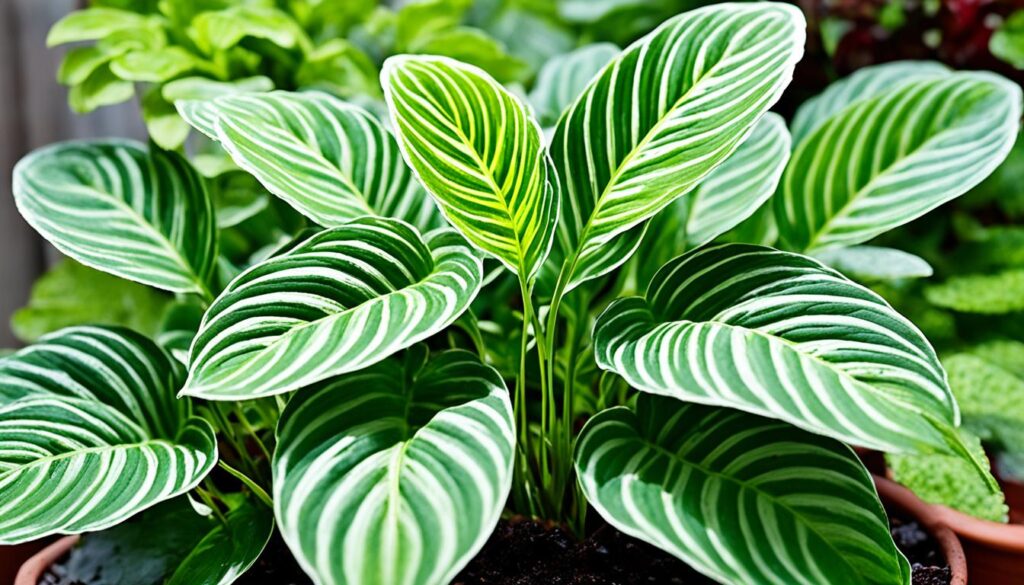
People love having this plant in their homes. It looks good on shelves or as the main attraction.
Light Requirements for Prayer Plant
The prayer plant needs special light to grow well. It does best in bright, but not direct, sunlight.
Direct sun can hurt its leaves. Keep it away from harsh light.
Put your plant where it gets light through a curtain. This gives it the light it likes.
A room that’s naturally bright is also good. This helps the plant stay healthy.
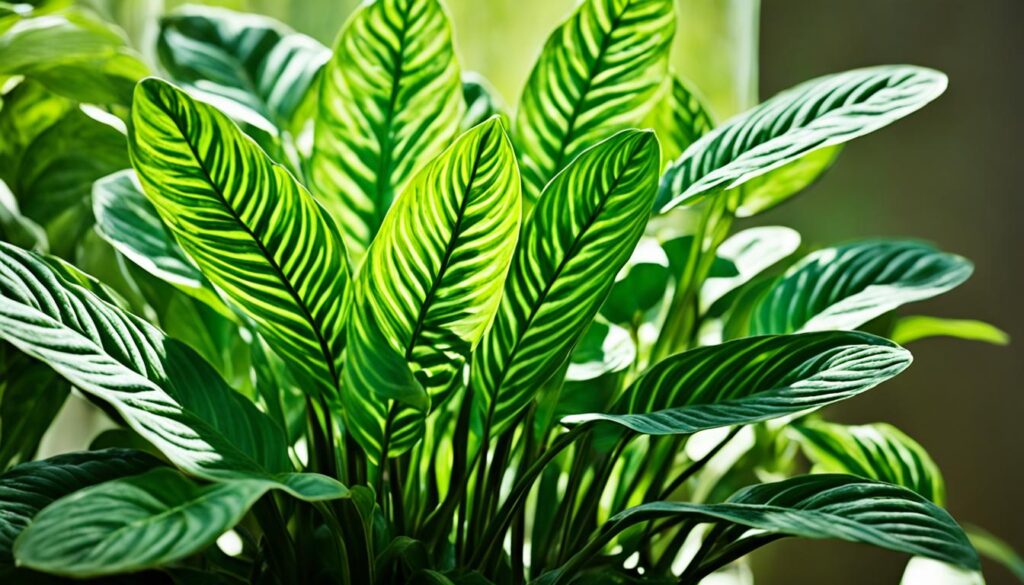
Plants inside need good light. Not enough natural light? Use special plant lights.
LED or fluorescent lights work great. They help your plant grow strong.
The prayer plant is good for darker spots. It makes any space brighter with its leaves.
Keep it out of direct sunlight. This keeps its leaves from getting burnt.
Watering Requirements of The Prayer Plant
Water is key for the prayer plant’s health. It needs the right amount to grow well. This plant needs moisture but not too much that the soil gets soggy.
An effective watering plan keeps the plant moist just right. Too much water causes root rot. Not enough means the leaves turn yellow. Learn the signs to water it perfectly.
Signs of Overwatering vs. Underwatering
Overwatering: It makes roots rot and leaves wilt. The leaves may turn yellow. You’ll smell something bad. The soil stays wet. If you see this, you’re giving it too much water.
Underwatering: Not enough water stresses the plant. Leaves dry out and curl. They might brown or wilt. The soil feels dry. Seeing this means it needs more water.
Here’s how to water your prayer plant right:
- Check the soil. Put your finger in an inch deep. If dry, it’s water time.
- Water it well until the extra water flows out. This makes sure all roots get water.
- Don’t let it sit in water. Remove any extra from the tray to avoid root rot.
- Keep an eye on humidity. High humidity means less watering.
- Change how you water as the weather and plant’s needs change. Think about temperature, humidity, and light.
Follow these tips and watch for signs of too much or too little water. This keeps your prayer plant happy and growing strong.
Fertilizing Prayer Plants
Fertilizing is vital for a prayer plant’s care. It provides needed nutrients for health and bright leaves. These nutrients help your prayer plant grow well and stay beautiful.
To get fertilizing right, know your plant’s needs. Use the right fertilizers at the right times. This helps your plant grow its best.
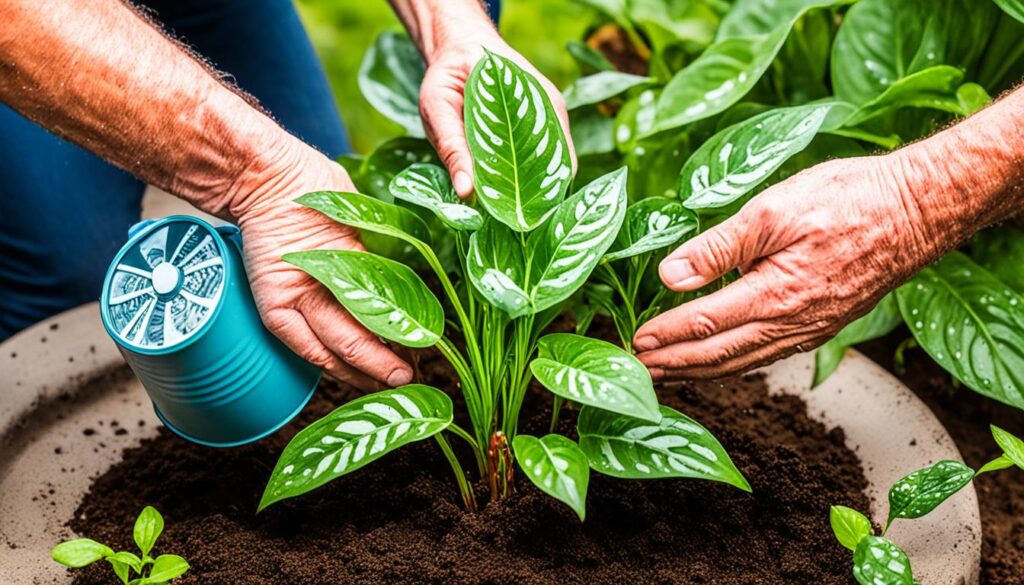
Recommended Fertilizer for Prayer Plants
Choose a fertilizer that fits your prayer plant. Use a balanced, water-soluble one. A mix of 20-20-20 or 10-10-10 works well.
These fertilizers give your plant needed nutrients. They help your plant grow healthy and have bright leaves. Nutrients like nitrogen, phosphorus, and potassium are key.
Follow the maker’s guide when you fertilize. Too much can hurt your plant. Dilute fertilizer properly to keep your plant safe.
You can also pick organic or slow-release fertilizers. These are good for indoor plants. They’re a greener choice for feeding your prayer plant.
Fertilize when your plant is growing, usually from spring to early fall. Cut back in late fall and winter when it rests.
Table
| Fertilizing Schedule | Recommended Fertilizer |
|---|---|
| Every 2-4 weeks during active growth | Water-soluble balanced fertilizer (20-20-20 or 10-10-10) |
| Every 2-3 months during dormant periods | Reduce or halt fertilization |
With regular fertilization, proper watering, and light, your prayer plant will flourish. It will show off its bright, healthy leaves.
Potting Prayer Plants
Potting prayer plants the right way is key for their health and growth. The correct pot size and mix are very important. Repotting gives room for roots to grow.
Choosing the Right Pot Size
Picking the right pot size for your prayer plant is important. Too small pots can hurt root growth. Too big pots may cause root rot.
A pot 1-2 inches larger than the current one is best. This size helps roots grow and keeps soil moist right. Think about your plant’s growth when choosing a pot.
Using the Right Potting Mix for Prayer Plants
The right potting mix is critical. It needs to drain well and have nutrients. A mix should be light, keep moisture, and have organic stuff.
Make a mix with peat moss, perlite, and good potting soil. This mixture drains well and stays moist. Don’t use heavy soil or too much sand.
Repotting When Necessary
Repotting is key for growing prayer plants. It’s time to repot if roots poke out, the plant is too big, or soil dries fast.
Take the plant out gently and check the roots. Loosen tight roots before repotting. Make sure it’s in the middle of the new pot.
Water well after repotting. Use a diluted fertilizer for extra nutrients.
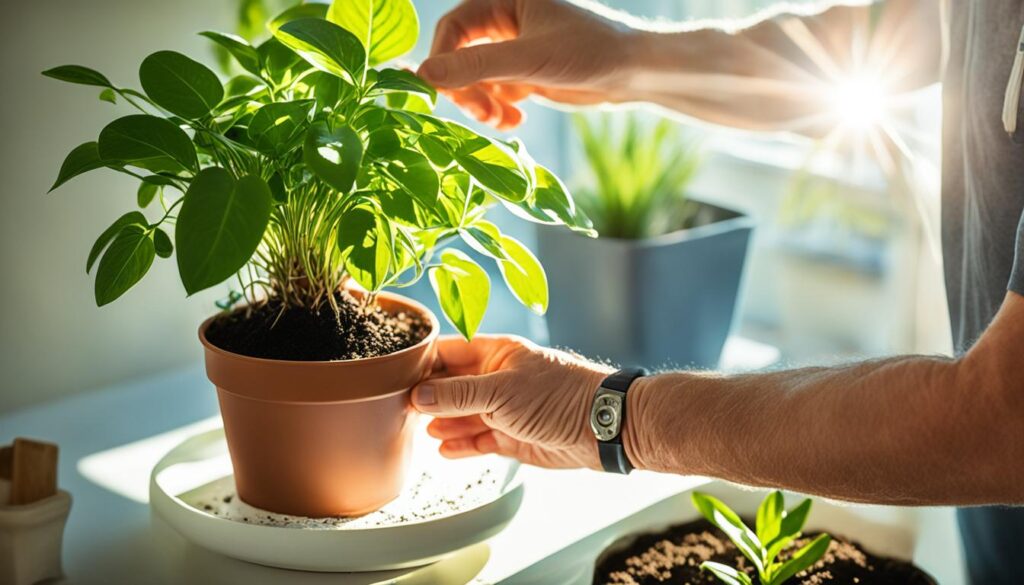
Propagating Prayer Plants
Expanding your plant collection is fun with prayer plants. You can use stem cuttings or division. Each method works well. It depends on what you prefer and what you have.
Stem Cuttings Or Seeds?
Stem cuttings are a great way to make more prayer plants. Here are the steps:
- Find a healthy prayer plant stem. It should have two leaf nodes.
- Cut the stem under a leaf node. Use a clean, sharp knife or shears.
- Take off the bottom leaves. Leave only two or three leaves at the top.
- Get a small pot ready. It should have good soil. Make a hole for the plant.
- Optional: Dip the stem end in rooting powder. This helps roots grow.
- Put the stem in the hole. Press the soil around it softly.
- Water it well. Cover it with a plastic bag or a lid to keep it humid.
- Place the pot in a spot that’s warm and bright, but not in direct sun.
- Keep the soil moist. Be careful not to water it too much.
- In a few weeks, roots and new growth should start to show.
- Once it’s strong and has new leaves, you can move it to a bigger pot.
Growing from seeds takes longer and is harder. Here’s how to do it:
- Get fresh seeds from a good place.
- Use a seed tray or pots with good soil for seeds.
- Wet the soil. Put the seeds on top. Press them in lightly.
- Cover the tray or pots with plastic or a lid to keep it like a greenhouse.
- Put them somewhere warm with light, but not direct sun.
- Keep the soil moist with a mist bottle or gentle sprinkling.
- Soon, the seeds will open, and small plants will come up.
- When they have a few real leaves, move them to their own pots.
- Take care of them like they are big prayer plants. Give them light, water, and food.
Division Of A Prayer Plant
Division is another way to make new prayer plants. It’s good when your plant is too big. Here are the steps to divide a prayer plant:
- Take the plant out of its pot gently. Be careful with the roots.
- Look for natural splits or new growth areas.
- Separate the plant into smaller parts. Use a clean, sharp knife or shears. Ensure each part has roots and stems.
- Prepare individual pots with good soil.
- Plant each part in its own pot. Make sure the roots are covered well.
- Water the new plants well. Put them somewhere warm and bright, but away from direct sun.
- Keep caring for them like full-grown prayer plants. They need light, water, and food.
Whether using stem cuttings or division, be patient and care for them well. Over time, your collection of prayer plants will grow. They’ll make your home beautiful. Or you can share them with friends.
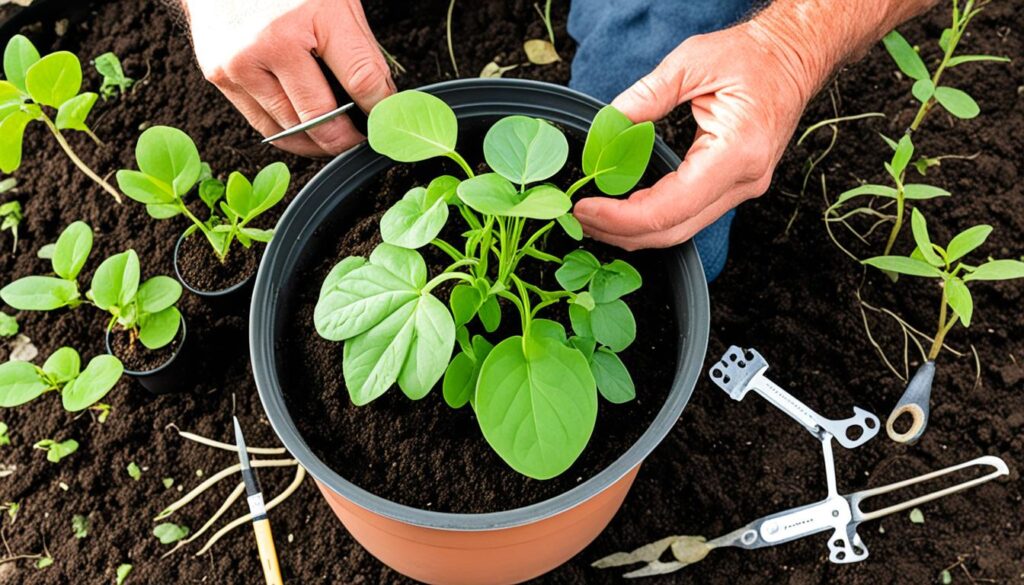
Growth and Development of Prayer Plants
It’s key to know how prayer plants grow. This helps us care for them well. They start small and grow through stages. Each stage needs special care.
Prayer plants start as tiny seeds or cuttings. They then grow roots and strong stems. They need the right moisture and warmth to sprout well.
Next, they begin making leaves. These leaves show cool patterns and bright colors. Each plant has its own pattern. As the leaves unfurl, they dance in the breeze, adding a vibrant touch to the surrounding environment. To ensure their beauty lasts, it’s essential to follow proper heartleaf plant care tips, such as providing the right amount of sunlight and moisture. With the right attention, these plants can thrive, showcasing their stunning patterns and colors for all to admire.
How fast they grow can change. Some grow quick, while others slow. Light, warmth, and food affect their growth.
They’re mature when their leaves fully develop. At this point, they do their signature leaf folding. Now, they just need regular care to stay healthy.
Here’s a picture to show how a prayer plant grows:
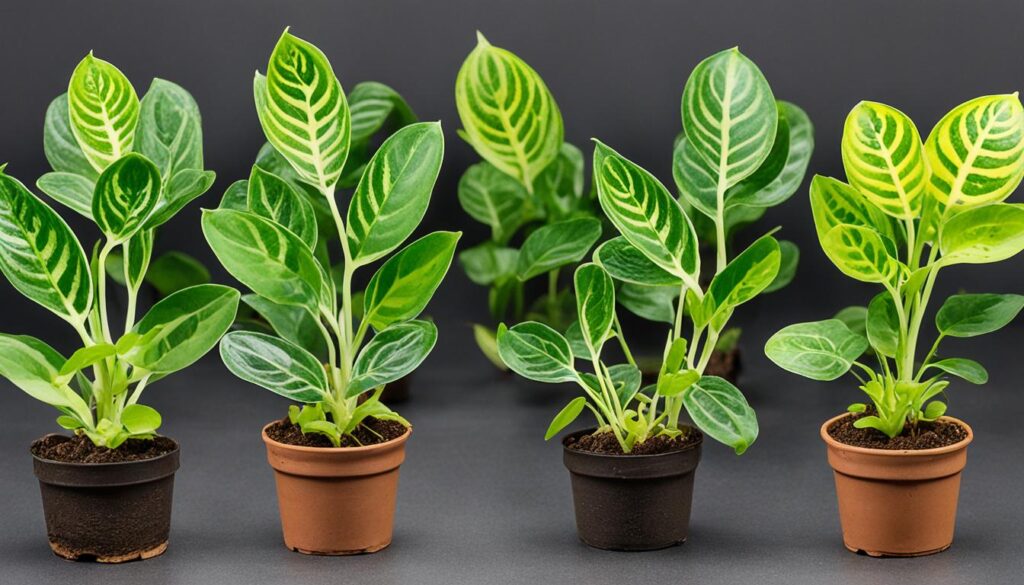
| Stage | Description |
|---|---|
| Sprouting stage | The initial growth stage where the plant develops roots and stems. |
| Leaf formation | Leaves begin to unfurl, revealing intricate patterns and vibrant colors. |
| Growth rate | The speed at which the prayer plant grows, influenced by various factors. |
| Maturity | The stage where the prayer plant has fully developed and exhibits its unique folding leaves. |
Learning about their growth helps us care better for prayer plants. The right conditions make them grow healthy and live long.
Dealing with Pests and Diseases in Prayer Plants
Prayer plants can get sick or have bug problems, just like other houseplants. It’s key to spot and fix these issues early. This keeps your prayer plant healthy and strong. I’ll tell you about common bugs, plant sicknesses, and how to keep them away.
Pest Control:
Spider mites and mealybugs can bother prayer plants. They hurt the leaves and slow down growth. Here’s how to fight these pests:
- Look closely at your plant for pests signs like webbing, stickiness, or tiny bugs.
- If you find bugs, keep that plant away from others to stop the spread.
- Use a wet cloth to wipe off any bugs or eggs from the leaves.
- For bad bug problems, try safe bug sprays or neem oil, and follow the directions.
- You can also bring in bug-eating helpers like ladybugs or special mites.
Disease Prevention:
Prayer plants can also get sick with things like root rot and leaf spots. Here are ways to keep your plant healthy:
- Don’t water too much. Let the top soil dry before watering again. Make sure water can drain well.
- Water the soil, not the leaves. Wet leaves can make the plant sick.
- Good air flow keeps the plant dry and lowers sickness chances.
- Take away any bad leaves to stop diseases from spreading.
- Always use clean soil and pots when you move your plant.
Using these tips for bug and disease care helps your prayer plant stay healthy. Keeping an eye on your plant makes it happy and pest-free.
Common Prayer Plant Pests
Prayer plants are strong but sometimes get pests. Spider mites and mealybugs are common.
How to Handle a Heavy Infestation
If you see many spider mites or mealybugs, act fast. This stops more damage.
- First, look at your plant well to see where bugs are.
- Cut off the really buggy leaves or parts. This keeps the bugs from spreading.
- Wash what’s left with mild soap and water or neem oil. This gets rid of bugs.
Keep checking your plant. Take off bugs or sick leaves to stop bugs from coming back.
Natural Predators
Using natural predators helps control spider mites and mealybugs. Ladybugs, lacewings, and predatory mites eat these pests.
Tip: You can buy these helpers at garden stores or online.
Isolate Infected Plants
Got a sick plant near others? Move it by itself. This keeps bugs from moving.
Tip: Put the sick plant somewhere else. Do this until it gets better.
Chemical Treatment
Sometimes, you need bug spray if nature’s way doesn’t work. Pick safe ones for inside and right for these bugs.
Caution: Use it right. Follow the guide and be safe. Keep away from kids and pets.
Dealing with pests fast helps your prayer plant stay healthy and grow well.
Disease Prevention For Prayer Plants
Keeping your prayer plant safe from diseases is very important. Follow these simple tips to keep it healthy.
1. Provide proper care: Good care is the best way to protect your prayer plant. Give it the right light, water, and food. Find out what your plant specifically needs and do those things well.
2. Maintain cleanliness: Keep your plant’s area tidy. Clean the leaves and the soil often. This stops dust and germs from gathering.
3. Use sterile soil: Always use clean soil for your plant. This keeps away bad germs. Clean soil helps stop diseases like root rot.
4. Avoid overwatering: Too much water is bad. It can cause root rot. Water your plant only when the soil’s top is dry. Use pots that let water out easily.
5. Monitor for signs of disease: Watch your plant for any bad signs. These include droopy leaves or spots. Act fast if you see problems to stop them from spreading.
6. Isolate infected plants: If a plant gets sick, keep it away from others. This helps protect your healthy plants. It also lets you take care of the sick plant better.
7. Provide proper air circulation: Good air flow stops too much moisture. This helps keep away fungus. Make sure your plant isn’t too close to other plants.
8. Avoid cross-contamination: Be clean when you touch your plant or others. Wash your hands and tools well. This stops germs from moving between plants.
9. Remove affected leaves: Take off leaves that look really sick. This helps the rest of your plant stay healthy. It stops the sickness from spreading.
10. Seek professional help if needed: If you’re not sure about a sickness or if things get worse, ask an expert. They can offer advice and how to make your plant better.
Preventing disease is the best way to care for your prayer plant. With good prevention and care, your plant will be healthy and happy for a long time.
Tips for Maintaining Prayer Plants
Wiping Leaves
Regularly cleaning your prayer plant’s leaves is very important. Dust can gather on the leaves over time. This can harm the plant’s health and looks. Use a soft, damp cloth to gently clean each leaf. This helps the leaves stay healthy and breathe well. Always hold the leaf gently with one hand while you clean with the other. This is to avoid harm to the fragile leaves.
Outdoor Exposure
Prayer plants usually live inside, but they like being outside sometimes. In the warm months, take your plant outside for some air and sunlight. But, make sure it is not in direct sun. The leaves could get burnt. Choose a spot with shade or partial sun, similar to indoors. Watch your plant for any unhappy signs and bring it inside if needed.
Adjusting Watering Schedule
The watering needs of your prayer plant can vary with the seasons. It might need more water in the warm months. But it needs less water when it’s cooler. Feel the soil with your finger to check moisture. Water the plant if the soil feels dry. Change how often you water based on the season. This is to avoid too much or too little water, which is bad for the plant.
Keeping your prayer plant healthy requires good care. Clean the leaves, give it some outdoor time, and adjust when you water. Do these things all year to make sure your prayer plant stays happy and pretty.
| Maintenance Tips | Frequency |
|---|---|
| Wiping Leaves | Once every 2 weeks |
| Outdoor Exposure | A few hours every 2 weeks |
| Adjusting Watering Schedule | Monitor soil moisture weekly |
Tips for Successful Overwintering of Prayer Plant
Keeping your prayer plant healthy in winter needs special care. Follow these tips to help it:
- Temperature Control: Keep the temperature between 60-75°F (15-24°C). Avoid sudden cold or drafts. These can harm your plant.
- Indoor Plant Protection: Keep your plant away from cold windows and doors. A sheer curtain can keep the chill away.
- Adjusting Watering and Lighting Conditions: In winter, your plant needs less water and light. Let the soil’s top inch get dry before watering again. Fertilize less often. Move your plant to a less sunny spot to match winter light.
Growing Prayer Plant from Seed
Growing a prayer plant from seed is rewarding and exciting. You get to see its full life cycle. I’ll show you how to do it and share important tips.
Seed Propagation:
First, get quality seeds. You can buy them or collect from a mature plant.
Then, do the following:
- Make a mix with equal peat moss and perlite.
- Fill small trays or pots with this mix.
- Wet the mix until damp but not too wet.
- Put 2-3 seeds on the mix in each tray or pot.
- Push them into the soil so they touch the damp mix.
- Cover them with a bit of vermiculite or sieved mix for insulation.
- Place the trays or pots in a warm, bright place away from direct sun.
- Keep the mix moist by misting or bottom watering.
- Don’t water too much, so seeds don’t rot.
- Seeds should sprout in 2-3 weeks.
Seedling Care:
After seeds sprout, it’s time to care for the seedlings. Here are tips:
- Move seedlings to their own pots once they have true leaves.
- Use pots with holes and well-draining mix.
- Place pots in bright, indirect light.
- Keep the soil moist but not too wet.
- Keep humidity moderate by using trays of water or a humidifier.
- Keep them away from drafts or sudden temperature changes.
Gradual Acclimatization:
Seedlings need to get used to new places slowly. Here’s how:
- Start with a few hours of filtered sun when they’re strong enough.
- Slowly let them have more sun over weeks.
- Watch for signs of stress like wilting or leaf burn. Adjust sun as needed.
- Once used to it, they can stay in their new spot.
| Benefits of Growing Prayer Plant from Seed | Considerations |
|---|---|
|
|
Varieties of Prayer Plant
Prayer plants come in many stunning types. Each type looks unique and pretty. They brighten up any indoor place with their colorful leaves and patterns. Let’s look at some special kinds of Maranta plants.
The tricolor prayer plant is very popular. It has green leaves with bold red lines. This plant adds drama and beauty to a room. It is perfect if you want a plant that stands out.
Then there’s the red prayer plant. Its leaves are rich red with neat patterns. This plant catches your eye and brings color to your space. It makes a beautiful centerpiece in a home or office.
Some people love the classic green prayer plant. It has lush green leaves with light patterns. This plant brings peace and beauty. It’s great for any indoor garden or collection.
The black prayer plant is really special. It has dark, velvety leaves. This plant stands out among other green plants. It brings elegance and mystery to any place. It’s a plant that starts conversations.
You might like the pretty tricolor, the bright red, the peaceful green, or the mysterious black prayer plant. Each plant in the Maranta family is unique. They make your home feel closer to nature and more peaceful. There’s a perfect prayer plant for everyone. Let their beauty brighten your indoor world.
FAQ
Q: Why do we love the prayer plant for apartments?
A: People love the prayer plant for their homes because it’s good inside. It doesn’t need much space. So it’s great for small apartments.
Prayer plants also do well in low light. They look pretty and are easy to care for. This adds life to any home.
Q: Which is the best room for a prayer plant?
A: The best spot for a prayer plant depends on what it needs. It also depends on the feel you want in your home.
But these plants can do well in many rooms. Like your living room, bedroom, bathroom, or office.
Q: Is the prayer plant air-purifying?
A: Yes, the prayer plant helps clean the air. It makes the air better in a room.
Q: Is the prayer plant pet friendly?
A: Yes, it’s safe around pets. It won’t harm cats or dogs.
Q: How big does the prayer plant get?
A: Inside, a prayer plant can grow up to a foot tall. This makes it perfect for small places.
Q: How to grow a prayer plant?
A: To grow one, you need to know what a prayer plant needs. You have to give it the right pot, soil, light, water, and food.
This guide will help you take good care of your prayer plant. So it can grow well and stay healthy.
Q: What does the prayer plant look like?
A: The prayer plant has big leaves with cool designs and bright colors. There are different kinds with different patterns.
Some have red lines, and some have dark spots. People love these plants because they look so nice.
Q: What are the light requirements for a prayer plant?
A: It likes bright light but not right from the sun. Too much sun can hurt its leaves.
Knowing the best light will help your plant do well.
Q: How often should I water my prayer plant?
A: Watering right is key. The soil should be moist but not too wet.
Too much water can cause problems, and so can too little. This guide will tell you how to keep the water just right.
Q: What fertilizers are recommended for prayer plants?
A: Feeding your plant helps it grow strong and look good. We’ll show you the best food for it.
Following these tips will help your plant stay healthy.
Q: How do I pot my prayer plant?
A: Putting your plant in the right pot is important. This guide will help you pick the perfect pot and soil.
It will also tell you when it’s time to move it to a bigger pot.
Q: How can I propagate my prayer plant?
A: Making more plants is fun. You can use stem cuttings or split the plant.
This guide will show you how, step by step. It makes sharing your plants easy.
Q: How does a prayer plant grow?
A: Learning how your plant grows is interesting. It helps you take care of it better.
This guide covers how fast it grows and what it needs to be healthy.
Q: How do I deal with pests and diseases in my prayer plant?
A: Sometimes plants get bugs or sick. This guide tells you what to look for.
And how to deal with any problems, so your plant stays happy.
Q: How do I handle a heavy infestation of pests on my prayer plant?
A: This section gives you info on dealing with lots of bugs. Like spider mites and mealybugs.
It will cover natural ways to get rid of them.

